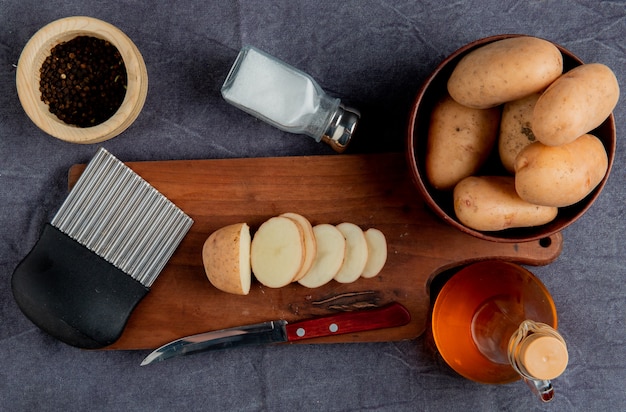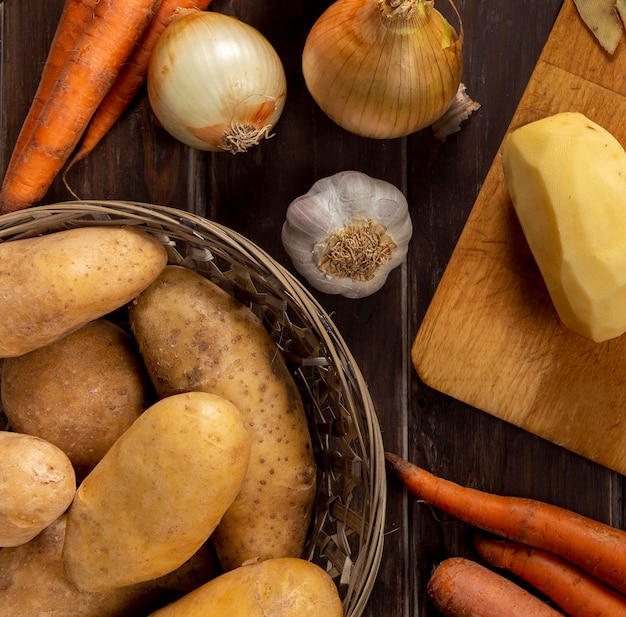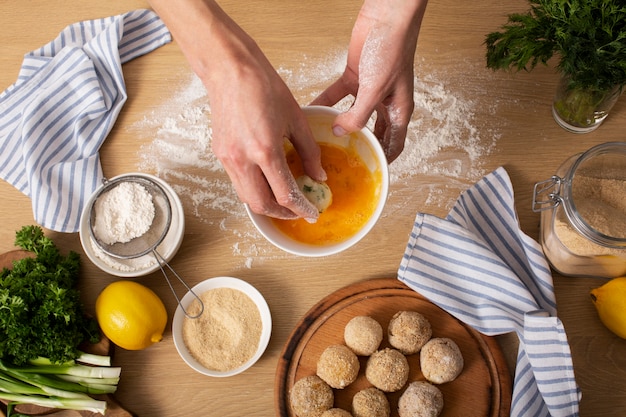Yams. Just the word conjures up memories, doesn't it? For me, it's a warm kitchen, the aroma of something comforting baking, and my mum's signature dish: roasted yams with a sprinkle of salt and a pat of butter. It's a simple pleasure, but one that always brings me back to those childhood days. But let me tell you, yams are so much more than just a childhood favourite. They're incredibly versatile, packed with nutrients, and absolutely delicious. Today, I'm going to share with you everything I've learned about cooking yams, from the basics to some more adventurous recipes. Grab a cuppa and let's get started!
(Part 1) All About Yams

First things first, let's clear up the whole yam/sweet potato confusion. You know, you see those two words used interchangeably all the time, and it can be a bit of a head-scratcher. But trust me, they're different! A yam is starchy, often with a rough, dark skin, and a denser texture. Think of it as a sturdy root, perfect for those hearty, grounding dishes. sweet potatoes, on the other hand, are sweeter, with a smooth, sometimes pale skin, and a softer texture. They're the ones that bring a touch of sweetness and light to any meal.
For this guide, we're diving into the world of yams. Their earthy, slightly sweet flavour and versatility make them a culinary treasure.
Choosing the Right Yams
When you're at the market, you want to pick yams that are firm and free of any blemishes or signs of damage. Think of them like you'd think of an apple – you want a good one! A smooth, unblemished skin is a good sign. If you're unsure, give them a gentle squeeze. They should feel firm and springy, like a bouncy ball. If they feel soft or mushy, those are probably best left on the shelf.
Storing Your Yams
Once you've brought your yams home, treat them right! Store them in a cool, dry place, away from direct sunlight. Don't even think about putting them in the fridge – they'll dry out! They'll stay fresh for a couple of weeks if you keep them in a cool, dark spot. Now, if you're planning to use them within a few days, wrap them in a paper towel and then in a plastic bag. It's a little extra effort, but it helps keep them fresh and moist.
(Part 2) Preparing Your Yams

Alright, let's get our hands dirty! The first step in cooking yams is to get them ready, and that means cleaning and peeling.
Cleaning and Peeling
First, give those yams a good scrub under cold running water. We're removing any dirt or debris, so be thorough. Now, grab a sharp peeler or a paring knife. The skin on yams can be a bit tough, so a sharp peeler is your best friend here. If you're using a peeler, hold the yam firmly with one hand and gently run the peeler along the surface. If you're using a knife, hold it at a 45-degree angle and slice away the skin. Be careful, though, yams can be slippery! Once you've peeled those beauties, you can chop them into smaller pieces, depending on what you're making.
Boiling
Boiling is a simple and reliable way to cook yams. It's perfect for when you want a quick and easy side dish or when you're using them as a base for a recipe like a soup or stew. Here's how you do it:
- Bring a large pot of water to a rolling boil.
- Add your peeled and chopped yams to the boiling water.
- Reduce the heat and simmer for about 20-30 minutes, or until they're tender.
- To check if they're done, pierce them with a fork. If it goes in easily, they're ready!
Baking
Baking is a great way to bring out the natural sweetness of yams, and it gives them a beautiful golden brown colour. Here's how to bake yams to perfection:
- Preheat your oven to 180°C (350°F).
- Cut your yams into cubes or wedges. You can keep them chunky or make them smaller, depending on your preference.
- Toss them with a little olive oil, salt, and pepper. You can add other spices here too – I love a sprinkle of cinnamon or nutmeg.
- Spread them on a baking sheet. Make sure there's enough space between the pieces so they cook evenly.
- Bake for about 20-25 minutes, or until they're tender and golden brown.
Roasting
Roasting is similar to baking, but it gives the yams a more intense flavour, especially when you roast them with other ingredients like garlic, onions, or herbs. Here's the roasting process:
- Preheat your oven to 180°C (350°F).
- Cut your yams into larger pieces. We're going for those hearty chunks that absorb flavour.
- Drizzle them with a little olive oil, and season them with salt, pepper, and any other spices you love. I often add a bit of cumin or paprika for a smoky flavour.
- Roast them for about 30-40 minutes, or until they're tender and slightly caramelized.
(Part 3) yam recipes: A Feast for the Senses

Now, let's get into some delicious recipes. Here's where we unleash the versatility of yams. We're going from the classic to the adventurous, so get ready to explore!
Classic Roasted Yams
This is a tried and true recipe, perfect for a weeknight meal or a special occasion. The simple combination of sweet, earthy yam, with just a touch of salt and pepper, is a real crowd-pleaser.
- Preheat your oven to 180°C (350°F).
- Cut the yams into chunks. About 2-inch cubes are a good size.
- Toss them with olive oil, salt, and pepper.
- Roast for 30-40 minutes, or until they're tender. You'll know they're done when they're fork-tender and have a lovely golden brown colour.
- Optional: For a touch of sweetness, drizzle with maple syrup or honey before serving.
Mashed Yams with Butter and Cinnamon
This recipe is pure comfort food. It's simple, creamy, and perfect for a cozy dinner. The cinnamon adds a warm, inviting flavour that pairs beautifully with the sweetness of the yams.
- Boil the yams until they're tender. You can use the same method as above.
- Drain the yams and mash them until they're smooth. You can use a potato masher or a fork, or even a food processor for a super smooth consistency.
- Add butter, salt, and a pinch of cinnamon. You can add more butter or cinnamon depending on your preference.
- Mix everything together until it's well combined and smooth.
- Serve immediately, or keep it warm for later.
Sweet Potato and Yam Curry
This curry is a real flavour explosion! It's packed with vibrant spices and a creamy coconut milk base. You can make it vegetarian, or add chicken or tofu for a more protein-packed meal.
- Dice the yams and sweet potatoes into roughly 1-inch cubes.
- Sauté onions, garlic, ginger, and your favourite curry spices in a pan with a little oil until fragrant. I love to use a combination of turmeric, cumin, coriander, and curry powder.
- Add the diced yams and sweet potatoes and cook for a few minutes, stirring occasionally.
- Pour in coconut milk. You can use full-fat or light coconut milk, depending on your preference.
- Bring the curry to a simmer and cook until the yams and sweet potatoes are tender, about 20-25 minutes.
- Season with salt and pepper to taste.
- Serve with rice or naan bread.
Yam Fritters
These fritters are a delicious snack or appetizer, perfect for a party or a casual gathering. They're crispy on the outside, soft and fluffy on the inside, and full of flavour.
- Grate the yams. You can use a box grater or a food processor.
- Mix the grated yams with flour, eggs, and your favourite spices. I like to add a pinch of cumin, paprika, and garlic powder for extra flavour.
- Heat a little oil in a frying pan over medium heat.
- Spoon the yam mixture into the pan, shaping them into small patties.
- Fry the fritters for about 3-4 minutes per side, or until they're golden brown and crispy.
- Serve hot with a dipping sauce like sweet chilli sauce, yogurt dip, or a mango chutney.
(Part 4) Sweet Yam Delights
Yams are not just for savoury dishes! They can also be used to create delicious and satisfying desserts.
Yam Cake
This cake is moist, sweet, and a fantastic alternative to traditional cake recipes. The yam adds a subtle sweetness and a rich texture that's truly delightful.
- Mash cooked yams until smooth. You can use the boiling method to cook the yams for this recipe.
- Mix the mashed yams with flour, sugar, eggs, and your favourite spices. I often add a pinch of cinnamon and nutmeg for a warm, comforting flavour.
- Pour the batter into a greased and floured loaf pan or cake tin.
- Bake for about 45-50 minutes, or until a toothpick inserted comes out clean.
- Let the cake cool slightly before serving. You can top it with icing, whipped cream, or a dusting of powdered sugar.
Yam Smoothie
This smoothie is a great way to start your day or enjoy a refreshing treat. It's packed with nutrients and a subtle sweetness that will satisfy your cravings.
- Blend cooked yams with milk, yogurt, and your favourite fruits. Bananas and berries are a great choice, but feel free to experiment with other fruits you enjoy.
- Add a dash of honey or maple syrup for extra sweetness.
- Blend until smooth and creamy.
- Serve immediately and enjoy!
Yam Pie
This pie is a real showstopper! It's similar to sweet potato pie, but with a slightly earthier flavour. It's perfect for special occasions or when you want to impress your guests.
- Make a pastry crust. You can use your favourite pie crust recipe or buy a pre-made crust.
- Fill the crust with mashed yams, spices, and a touch of sweetness. I like to use cinnamon, nutmeg, and a little brown sugar for flavour.
- Bake the pie until the crust is golden brown and the filling is set.
- Serve warm with a scoop of vanilla ice cream or whipped cream.
(Part 5) Yams for Health
Beyond their deliciousness, yams are a nutritional powerhouse! They're packed with vitamins, minerals, and fibre, making them a healthy addition to your diet.
Benefits of Eating Yams
Here's a rundown of the health benefits of yams:
- Improved digestion: The high fibre content in yams helps to keep your digestive system running smoothly, preventing constipation and promoting regularity.
- Boosts immunity: Yams are a good source of vitamin C, an essential nutrient for boosting your immune system and protecting you from illness.
- Controls blood pressure: Yams are rich in potassium, a mineral that helps regulate blood pressure and keep your heart healthy.
- Promotes healthy skin: Yams are packed with antioxidants, which help to protect your skin from damage caused by free radicals. This can help to prevent wrinkles, fine lines, and other signs of aging.
(Part 6) Yams Around the World
Yams are a staple food in many parts of the world, particularly in Africa, Asia, and the Caribbean. They're a versatile ingredient that's used in a wide range of dishes, from simple stews to elaborate desserts.
Some Popular Yam Dishes
Here's a glimpse into the diversity of yam cuisine around the globe:
| Dish | Origin | Description |
|---|---|---|
| Fufu | West Africa | A doughy dish made from boiled and mashed yams, often served with stews or soups. It's a staple food in many West African countries, often enjoyed as a side dish or as a base for sauces and stews. |
| Yam Porridge | West Africa | A thick porridge made from boiled and mashed yams, often eaten for breakfast. It's a comforting and filling meal, often enjoyed with other ingredients like beans, fish, or vegetables. |
| Yam and Coconut Soup | Caribbean | A creamy and flavorful soup made with yams, coconut milk, and spices. This is a popular dish in many Caribbean countries, known for its rich, creamy texture and delicious blend of flavors. |
| Yam and Groundnut Stew | West Africa | A hearty and flavorful stew made with yams, groundnuts, and spices. This is a staple dish in many West African countries, often enjoyed with rice or fufu. The rich peanut sauce adds a satisfying creaminess to the dish. |
(Part 7) Yams and Sustainability
Beyond their taste and nutritional value, yams are also an environmentally friendly food source. They're relatively easy to grow and can thrive in a variety of climates, making them a valuable resource for communities around the world.
Growing Yams
If you're feeling adventurous and want to try growing your own yams, they're best grown in a warm, sunny climate with loose, well-drained soil. They need regular watering, but don't overwater them – they can be prone to root rot. The best time to plant yams is in the spring or early summer. Remember, patience is key! It can take 4-6 months for them to mature.
(Part 8) FAQs: Your Yam Questions Answered
Let's address some common questions you might have about yams.
1. What's the Difference Between Yams and Sweet Potatoes?
As I mentioned earlier, although they're often confused, yams and sweet potatoes are two different root vegetables. Yams are starchy, typically have a rough, dark skin, and a drier texture, while sweet potatoes are sweeter, have a smooth skin, and are generally more moist.
2. How Can I Tell If a Yam Is Ripe?
To check for ripeness, give the yam a gentle squeeze. It should feel firm and springy, not soft or mushy. Avoid any yams with soft spots or signs of damage.
3. How Long Do Yams Last?
Yams can last for a couple of weeks if stored properly in a cool, dry place. Avoid refrigerating them as this can make them dry out.
4. Can You Eat Yam Skin?
While some people do eat the skin, it's generally tough and fibrous. It's best to peel it before cooking.
5. What Can I Do With Leftover Cooked Yams?
Leftover cooked yams are a great resource for your kitchen! You can add them to soups, stews, or salads. Mash them and serve them as a side dish, or even freeze them for later use. They're incredibly versatile.
(Part 9) The Yam Adventure Awaits!
So, there you have it, your comprehensive guide to cooking delicious yams! From the basics of choosing, preparing, and storing to a wealth of recipes and health benefits, you're now ready to explore the wonderful world of yams. Remember, the key is to experiment, have fun, and discover what you love. Get creative with spices, textures, and flavour combinations. I hope this guide inspires you to embrace yams in all their glory. Bon appétit!
Everyone is watching

How to Cook Frozen Lobster Tails Perfectly: A Step-by-Step Guide
RecipesLobster. Just the word conjures up images of lavish meals, special occasions, and a taste of luxury. But let's...

Pigs in a Blanket Cooking Time: How Long to Bake for Perfect Results
RecipesAh, pigs in a blanket. Just the name conjures up images of those delightful little parcels of crispy pastry en...

Pork Fillet Cooking Time: How Long to Cook It Perfectly
RecipesPork fillet, or tenderloin as it's sometimes called, is a real favourite in our house. It's so versatile, and...

The Ultimate Guide to Tender, Juicy Pulled Pork
RecipesRight, let's talk pulled pork. It's one of those dishes that just screams "comfort food," doesn't it? I mean...

The Ultimate Guide to Cooking Sweet Potatoes: From Roasting to Mashing
RecipesSweet potatoes. Just the name conjures up images of warm, comforting dishes, bursts of vibrant color, and a to...
